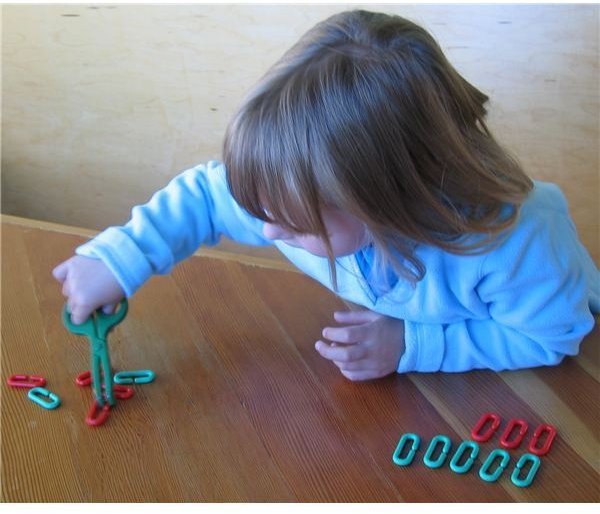Providing Activities That Develop Fine-Motor Control: Help Kids Learn to Cut With Scissors
Grasping Tiny Objects Prepares the Hand for Cutting with Scissors
Manipulating small objects helps young children to eventually cut with scissors. Babies actually begin preparing for this when they use the index finger to point and grasp tiny pieces of cereal between the index finger and thumb. Fine-motor control develops as the index and middle fingers and thumb work together to grasp while the ring and pinky fingers help stabilize them. Toddlers should be encouraged to use the index finger and grasp tiny objects as they engage in the following daily activities:
- Point during finger play songs.
- “Paint” with the index finger in whip cream.
- Put small pieces of crackers inside large container openings.
- Stack blocks.
- Put large pegs in or out of a board.
Toddlers should be closely supervised because they will likely put small objects into their mouths. However, these early fine-motor experiences are especially important for children who need early intervention due to delays in motor development.
Using Scissors Requires Sequencing and Language Skills
Developing fine-motor skills to cut with scissors involves learning to sequence the opening and closing motions of the two loops while simultaneously moving the blades across paper. Children should learn language concepts such as “open and close” and “in and out” as they put paper inside the blades and open/close to cut. Two-year-old children are ready to practice the following fine-motor activities that will develop these skills:
·Stringing large beads.
·Putting objects inside containers/ dumping them out.
·Opening food wrappers.
·Opening and closing lids such as the top of a band-aid box.
Learning to Squeeze and Release Prepares Children to Control Scissors
Some adapted scissors actually involve squeezing and releasing a loop handle to make the blades open and close. Three-year-old children are ready to learn the concepts of “squeezing and releasing” by using squeeze toys that squirt water or squeezing bottles such as glue or food coloring during an arts and crafts project. Activities that involve squeezing or manipulating with the index, middle fingers and thumb are especially important in developing the dexterity to manipulate scissors. Suggested activities for three and four year old children include:
·Opening and closing squeeze clothespins.
·Using toy pliers to move around objects.
·Opening or closing screw caps.
·Wind up toys.
Pre-school teachers will find that focusing on these preparatory skills will make using scissors easier for children with or without disabilities. Continuing to offer the fine-motor activities described in this article during the kindergarten year will help children to develop the motor control required to cut shapes and perform paper and pencil tasks.
